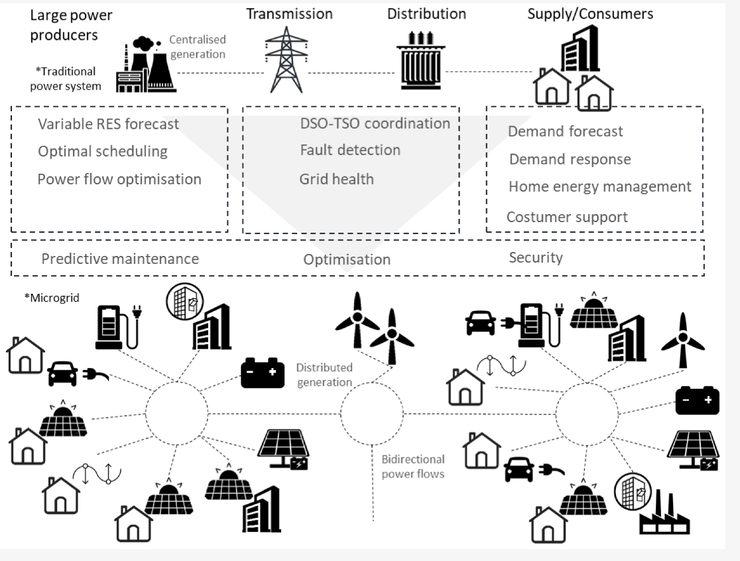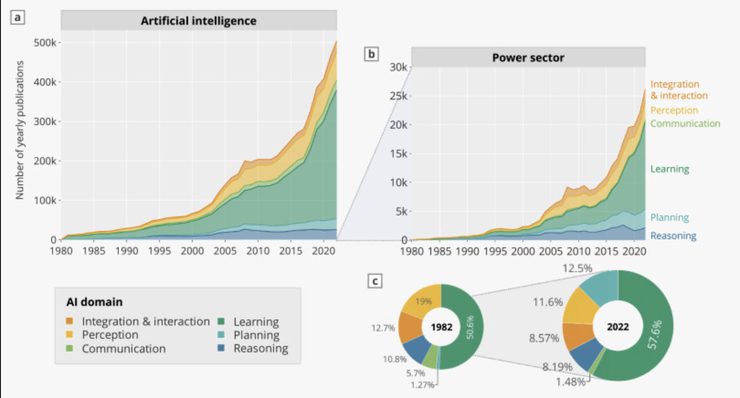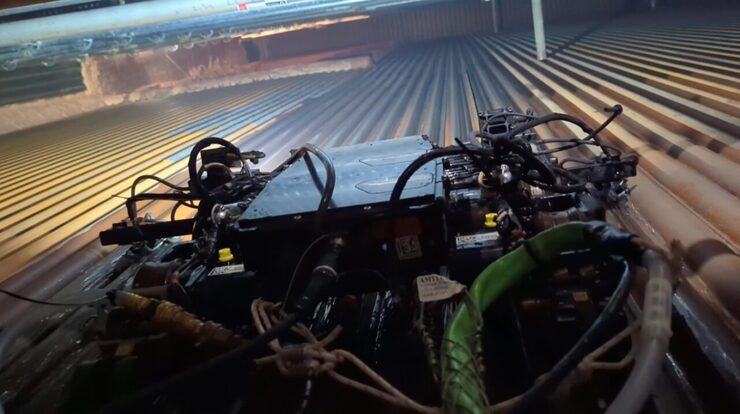AI’s Paradox in the Power Sector—Unleashing Potential but Confronting Uncertainty
Artificial intelligence (AI) is rapidly transforming the power sector, offering unprecedented opportunities for efficiency and innovation. But as AI applications proliferate, new challenges are emerging. How will industry navigate the potential and challenges that accompany this digital revolution?
Recent efforts to overhaul the long-established energy system in alignment with decarbonization and decentralization have introduced new intricacies and ambiguities, ushering in additional unknowns and intensifying the demand for dynamic adaptation. But, these attributes are emerging alongside sectoral digitalization—broader automation and problem-solving using digital tools. And while just one of a plethora of emerging aspects of digitalization, artificial intelligence (AI) has quickly gained prominence, inspiring fear and awe for its transformative potential.
AI itself is not completely new: Swiss researchers suggest its advent in the power sector emerged as expert systems—computer systems emulating human decision-making—and neural networks more than 30 years ago. While the recent AI boom stems from parallel breakthroughs in hardware performance, computational vision, and neuroscience, AI’s definition has only grown murkier.
Some definitions highlight its applicability as a system, a tool, or a solution, while others refer to it as a category that encapsulates a set of varying technologies. These, too, are disputed, but they mostly always include expert systems, machine learning (ML), deep learning, reinforcement learning, computer vision, and natural language processing.
For the sake of some standardization, Graeme Booth, head of Digital Technology at the UK Net Zero Technology Centre (NZTC), in a recent report, suggested renaming it altogether. “The term ‘AI’ is being confused and proliferates the internet,” he noted. “What we’re seeing is more akin to augmented intelligence—perhaps a better phrase as it’s not that the machine has intelligence and sentience, but instead that it can automate and assist many of our processes in a way that we never conceived possible, using machine learning, predictive analytics, and pattern recognition primarily. The proliferation of generative AI is augmenting our creativity, and with that comes fictional content, which, quite often, needs a human touch to refine.”
Most definitions also regularly underscore AI’s human-defined inputs. The current International Organization for Standardization/International Electrotechnical Commission (ISO/IEC) 22989 definition of an AI system, for example, presents it as: “An engineered system that generates outputs such as content, forecasts, recommendations or decisions for a given set of human-defined objectives.”
At its core, and particularly for the power sector, “AI techniques use a range of computational techniques to mimic human-style reasoning and problem-solving, most notably with neural networks that mimic the structure and connections of human brains,” Dr. Jeremy Renshaw, senior technical executive of AI, Quantum, and Nuclear Innovation at the Electric Power Research Institute (EPRI), recently explained to Congress.

A Flourishing Industry
Despite misgivings about how it is defined, the adoption of AI in the power sector has experienced a remarkable surge. Seeking a way to quantify the various AI solutions that have emerged, researchers from Croatia at the start of 2023 pinned down at least 220 AI-based companies, including startups and industry heavyweights, that operate in the global power sector. The trend “shows that the growing researcher interest in applying AI-based techniques in the power sector is accompanied by a growing number of companies following suit in real business applications,” it concluded.
And as EPRI’s Renshaw noted, AI has already successfully pervaded all parts of the power sector with wide applicability (Figure 1) “with the intent to improve safety, reliability, and efficiency as well as to reduce time and cost.” Swiss researchers who analyzed more than 259,000 research articles between 1982 and 2022, meanwhile, categorized the applications in neat buckets: reasoning, planning, learning, communication, perception, and integration and interaction (Figure 2). “Our findings indicate that, as of now, the focus is predominantly on AI applications in power retail (55%), transmission (14%), and generation (13%),” they noted.

AI for Power Generation
In generation, applications generally seek to optimize power plant operations and maintenance (O&M) or detect anomalies, exploiting advances in deep learning. Other applications center on forecasting, which is used for unit commitment, generation scheduling, economic dispatch, reserve estimation, and power system reliability.
Predictive maintenance appears to be emerging as a burgeoning focus. “AI tools can parse through substantial amounts of data and potentially identify early-stage trends in data that may lead to identification of future malfunctions and notify power plant and grid operators to schedule preventive maintenance ahead of these potential equipment failures,” Renshaw noted. EPRI has already applied such principles to wind turbine gearboxes to predict the onset of failures such that lower-cost preventive maintenance activities can be performed instead of larger-scale and more expensive repairs.
In just one of the hundreds of examples sector-wide, American Bituminous Power’s (AMBIT’s) 80-MW Grant Town Power Project—West Virginia’s only remaining coal refuse–fired facility—has partnered with robotics firm Gecko Robotics to leverage data-collecting robots (Figure 3), data integration, analytic tools, and software modules to “give plant managers incredible clarity,” Gecko Robotics co-founder and CEO Jake Loosararian told POWER. “There is no more guesswork—we can predict exactly what will fail, automate repair pans using AI to maximize budgets and increase the useful life of customer infrastructure.”

Asset optimization—efforts to maximize asset efficiency and reliability to balance performance with maintenance needs—is another major focus area. Stacey Jones, ABB’s global portfolio leader for Asset Performance Management (APM) solutions, told POWER ABB’s APM system is layered with AI and ML. “The first layer is more condition monitoring, which is simple threshold monitoring, which is not AI, and then some first principles models. Then, for our next layer of advanced protection, we have what we call our advanced prediction software—APM 360,” she explained. “This is where we start to bring in the AI in the ML” to essentially use the data “to train a model that’s looking for certain behavior or a set of characteristics, and anytime we diverge outside of that, then we’re going to throw out an alert, and ideally, you catch it.”
AI for Transmission and Distribution
AI applications in transmission networks, meanwhile, currently revolve heavily around transmission system expansion planning. Approaches so far have focused on sizing and siting transmission assets using heuristic and metaheuristic optimization techniques. However, applications with learning attributes are also burgeoning on the operations side, for example, to bolster fault protection or dynamic line rating. Splight, an AI grid management firm, suggested these prospects for AI are slated to thrive given the Federal Energy Regulatory Commission’s Order 881, which requires a transition from traditional static to the dynamic concept of ambient-adjusted ratings (AARs) for transmission lines.
“In the context of the power grid, AI algorithms are poised to revolutionize how we handle temperature data and make real-time adjustments to line ratings, providing an elegant solution to the intricate challenge of implementing dynamic line rating,” the company said. AI’s potential lies in real-time line rating adjustments and optimizing grid capacity utilization, which, in turn, improves efficiency while allowing the seamless integration of renewables. In addition, AI enables cost savings, enhances safety, and because it provides accurate load forecasting, it could bolster data-driven decision-making that caters to decarbonization, it said.
Distribution networks, too, are exploiting learning and planning, using various types of optimization algorithms for line routing and substation placement. AI is also assisting in automated fault location in distribution systems, stability analysis, and automated control. AI-based controllers are in addition well-suited for microgrid environments, though microgrid modeling also exploits the ability to compensate for non-complete or inexact models, and reinforcement learning.
Researchers at the University of California, Santa Cruz in November notably unveiled a “specific flavor” or reinforcement learning—constrained policy optimization (CPO)—to optimize how microgrids pull from various alternate sources of power. Unlike traditional systems using model predictive control (MPC), which bases decisions simply on the available conditions at the time of optimization, the CPO approach “takes into account real-time conditions and uses machine learning to find long-term patterns that affect the output of renewables, such as the varying demand on the grid at a given time and intermittent weather factors that affect renewable sources,” the university explained.
Broader Applications for AI Sector-wide
On the business front, AI applications are thriving in market operations and trading, such as for price forecasting, using probabilistic time series forecasting, and optimized aggregation and bidding of flexible demand. AI applications in the power retail business are meanwhile helping to predict electricity demand and peak loads—crucial inputs to power system planning—using learning attributes like multi-linear regression or artificial neural network models.
AI applications to mitigate longstanding business risks are also thriving. Paramount among these are for cybersecurity. By analyzing patterns and trends, AI algorithms can predict potential failures, cyber threats, and demand fluctuations, enabling proactive risk mitigation. AI offers the opportunity to be both an offensive and defensive force-multiplier for cybersecurity applications, noted EPRI’s Renshaw.
In tandem, AI shows promise for wildfire risk evaluation and detection. “These include analyzing satellite data to identify areas of higher risk as well as conducting real-time analysis of observation station camera data to look for smoke and trigger faster responses to deal with fires at earlier stages when they are easier to contain,” he said.
In addition, AI tools appear to be contributing to emissions reduction. Competitive generator Vistra, for example, in 2020 piloted a McKinsey QuantumBlack multilayered neural-network model to learn about the effects of complex nonlinear relationships (such as temperature and humidity) using two years’ worth of data gleaned from Vistra’s coal-fired Martin Lake Power Plant in Texas. It then deployed a heat rate optimizer (HRO) that enabled Martin Lake to run 2% more efficiently in just three months, saving the plant $4.5 million and abating 340,000 tons of carbon. Vistra has since rolled the HRO out to at least another 67 power-generation units across 26 plants, for an average 1% improvement in efficiency.
Finally, AI applications are also evolving for emissions monitoring. Beyond plant-based Predictive Emission Monitoring System (PEMS) solutions, such as pioneered by ABB in the late 2000s, at least one entity—Climate TRACE, a coalition originally funded in part by a Google.org grant—is monitoring power plant emissions from space, leveraging AI to “analyze over 90 trillion bytes of data from more than 300 satellites, more than 11,000 sensors, and numerous additional sources of emissions information from all over the world.” In 2023, it reported the world’s thermal power plants emitted 98.36 billion tonnes of carbon dioxide equivalent emissions—or 21.82% of total global emissions.
Steep Barriers for an AI Expansion
While lauded for its efforts to boost accountability, Climate TRACE has also triggered some apprehension in the power sector that satellite monitoring unveils sensitive emission data, illustrating two key barriers associated with AI: data privacy and data security. On the flip side, data sharing and accessibility are also growing concerns, given the hurdles many organizations encounter in obtaining high-quality data due to proprietary constraints, data silos, or apprehensions about disclosing sensitive information.
Another barrier is trusting the data itself. “Data is at the heart of all AI technologies. Without sufficient quantity, quality, and cleanliness of data, AI systems can potentially produce erroneous results,” Renshaw noted. That concern is especially growing prevalent as generative AI gains traction in the power industry. While a statistical model makes predictions based on rationale, a generative AI system can “hallucinate,” meaning it returns inaccurate responses, because they lack constraints that limit possible outcomes.
“Obviously, if you’re in an engineering environment, if you’re trying to solve operational issues, those aren’t good,” William Hendricks, vice president of sales for Cognite’s Americas business, noted in June during POWER’s 2023 Connected Plant Conference. To tackle that concern, Cognite last year launched an “intuitive, composable, visual workspace” dubbed “Industrial Canvas,” a collaborative environment that leverages contextualized data and generative AI.
Yet another emerging glaring issue concerns bias. “The datasets that are used to train AI models may suffer from bias, which is then transferred into the AI model. This can cause existing biases in data to be perpetuated or reinforced in the AI models used. As such, AI practitioners need to be aware of such potential biases and attempt to remove or eliminate their effects, such as using alternative datasets and cleaning the data,” Renshaw explained. Threats posed by bias are emerging specifically with the rise of AI in electricity market operations, given potential market abuse and distortions through automated or algorithmic trading. However, approaches that use AI to detect anomalies in power markets also appear to be evolving.
Along with bias, another barrier experts have highlighted concerns the massive task of data contextualization—the connection of data, using efficient data mining and data alignment, from various point solutions and systems within the organization to get a deeper data “story.” Renshaw, meanwhile, highlighted “the lack of explainability” as another key weakness in AI models. “A model can provide an answer, but few can provide an explanation or context clues of why it provided the response that it did,” he said. “AI explainability is a rapidly developing field and will continue to improve.”
On the business side of AI, costs are also a growing concern. “Cloud infrastructure costs, if you decide to go to the cloud, it’s a huge expense that I don’t think anybody saw coming, and now it’s a big portion of our budgets,” ABB’s Jones noted. While securing the right skill to sustain AI solutions poses another challenge, Jones also highlighted a larger need for change management. Change management involves systematically guiding individuals, teams, and organizations through the transition from existing practices to new processes and technologies. Its key goals are to overcome cultural resistance and foster buy-in. “If you don’t put the change management in place, something new like this will fall flat,” Jones said.
Looming Regulations
While the industry grapples with how to best leverage AI amid its bittersweet potential, the government has stepped up in notable ways to offer guidance, with an aim to foster the responsible use of AI. In October 2023, President Joe Biden issued Executive Order (EO) 14110, which establishes new standards for AI safety and security, protects privacy, and promotes innovation and competition. In the three months following the order, federal agencies have used the Defense Production Act to compel AI developers to provide vital information to the Department of Commerce. The Commerce Department, at the end of January, also proposed a rule that would require U.S. cloud providers to alert the government when foreign clients train the most powerful models, which could be used for harmful activity.
In addition, nine U.S. agencies recently completed risk assessments, providing a “basis” for continued action to ensure the U.S. remains at the forefront of safely integrating AI into vital aspects of society, like the U.S. electric grid, the White House noted in January. “Within the energy sector, the EO instructs the DOE [Department of Energy] to address AI systems’ threats to critical infrastructure by coordinating with the National Institute of Standards and Technology (NIST) to set rigorous standards, subject to so-called red team testing that simulates worst-case scenarios to ensure safe deployment of AI systems within energy infrastructure, all prior to the public release of the technology,” explained law firm Foley and Lardner in December. “The DOE is now beginning to establish rules and regulatory compliance in accordance with this executive order, a process that will take at least the next nine months.”
The EO follows the separate issuance of Artificial Intelligence Risk Management Playbooks by the DOE in August 2022 and NIST in January 2023 to help inform AI leaders, practitioners, and procurement teams, and better incorporate trustworthiness considerations in the design, development, and use of AI systems.
States, too, are considering potential regulation. During a June 2023 National Association of Regulatory Utility Commissioners webinar, New York State Public Service Commissioner Diane Burman noted any regulations for AI in the energy space would need to be pinned to an informed framework that considers use cases, current systems, and processes. “It wasn’t but just a few years ago that we struggled with getting drones to be utilized within the utility space for system planning and other things,” she noted. “Part of the challenge is also having the expertise with staff and then looking at data quality, access, and privacy issues,” she said.
Elsewhere around the world, the European Union in June 2023 enacted the world’s first comprehensive AI law, a risk-based approach that requires providers of high-risk AI systems in critical industries, like power, to complete an assessment to ensure systems conform with mandatory requirements for trustworthiness. Some European experts suggest the law will impose steep compliance costs on the energy sector, though they acknowledge more detailed data is needed on AI system costs, which could provide a clearer picture of the law’s impact on profitability.
—Sonal Patel is a POWER senior associate editor (@sonalcpatel, @POWERmagazine).